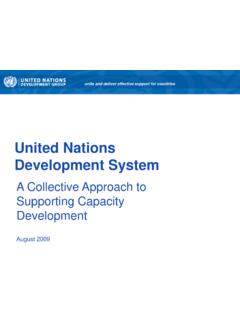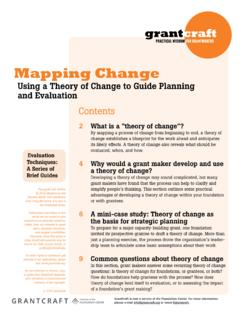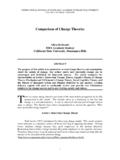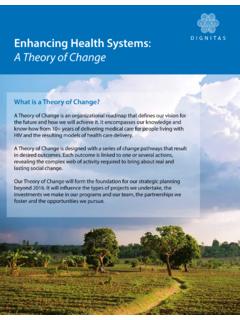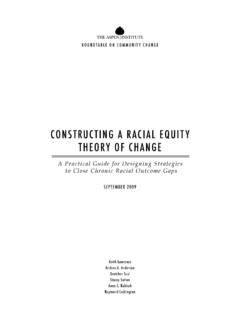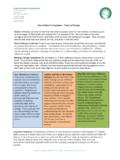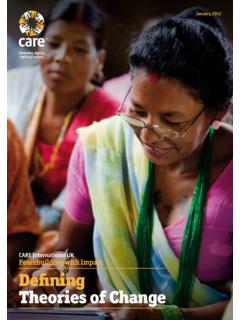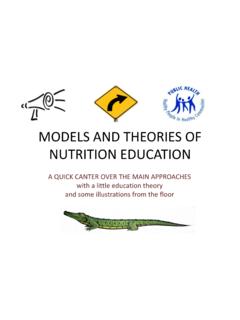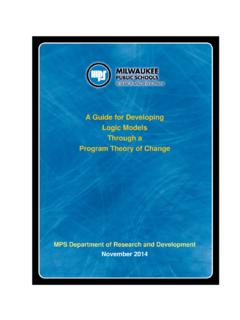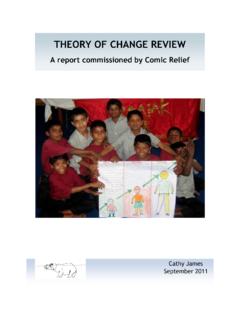Transcription of Theory of Change Concept Note - UNDG
1 Theory of Change1. Concept Note I. WHAT IS A Theory OF Change ? A Theory of Change describes how we believe that Change could be made to happen and outlines the main elements for that Change . It seeks to identify how we think that different factors could interact in relation to the Change and what the underlying assumptions and risks are. A Theory of Change is actually a very simple Concept : Throughout our work and personal lives we have aims, objectives and ideas about how to achieve our goals. However, we rarely take the time to think these through, articulate and scrutinise them, and make explicit the underlying beliefs and biases that shaped our thinking. All a Theory of Change process does is to make these assumptions and beliefs explicit and more testable. A Theory of Change is more than a narrative or graphic account of a results chain. Unlike the results chain and logframe, which have very specific roles in terms of accountability and measurement, the purpose of a Theory of Change is: Analytical Explanatory.
2 Learning by doing, and verifying against practice. It is the basis upon which we design a results chain and logframe, not the other way around. The Theory of Change lays out a working hypothesis subject to verification during and after implementation. Because it is a way of critical thinking, a Theory of Change can be developed for any level of intervention: a programme, a project, an organization, a policy, or a strategy. In recent years, several UN agencies have moved into Theory of Change thinking. UNDP, UNFPA, UNICEF. and UN Women have all presented theories for their main areas of work to their Executive Boards over the past year or so. While the Concept is simple, many different terms have been used over the years to describe an approach that is based on a plausible and sensible model of how the programme is supposed to work. There is a great variety of terms used.
3 These terms are not always used interchangeably; sometimes they have particular meaning, but these vary widely. ( : Causal chain, Causal model, Cause map, Impact 1 This document has been prepared jointly by the Peer Support Group (PSG) and the UNDG LAC Secretariat to provide support to RCs/UNCTs in the application of the Theory of Change as included in the new Interim UNDAF. guidance. Prepared by the UNDG LAC Secretariat/PSG. October 2016 1. pathways, Intervention Theory , Outcome Change , Outcome line, Program Theory , Results chain, Theory - based evaluation, Theory -driven evaluation, Theory of action). Terminology in the UN. Typically, while the UN wrestles with the implications of introducing something new like the Theory of Change , it also seem to be wrestling with the basic question of how to define it. Unlike other RBM and programming terms there is no settled definition and understanding of Theory of Change across the UN.
4 What we are seeing at this point are slightly different interpretations of what it means, what the underlying process is, and what the final product looks like. This note proposes a way forward on how to build a Theory of Change after a review of existing literature and UN practice. II. HOW TO DEVELOP A Theory OF Change ? 1. Analysis of Situation and Context 6. Turn it into a 2. Identify Pre- narrative conditions 3. Identify Role 5. Validate it of Related Parties 4. Make assumptions and risks explicit Prepared by the UNDG LAC Secretariat/PSG. October 2016 2. 1. Analysis of Situation and Context Theory of Change starts with the analysis of a situation and context that needs Change , and the identification of the desired Change . This involves a thorough context analysis drawing on data and evidence from the Common Country Analysis (CCA). Since a CCA includes a causal analysis, including structural factors that explain, for instance, political instability, high levels of violence, exposure to hazards, weak state capacities, and persisting (gender) inequalities and discrimination in a particular country, those information could be used for the situation and context analysis in the formulation of a Theory of Change .
5 There are other specific analysis relevant in developing a ToC. They are as follows: Comparative Advantage Analysis: This involves analysing where the UN and specific UN Agencies comparative advantages are, where we can provide the best added value, and whether it is efficient in providing a result on specific paths, hence prioritizing which one(s) are the best likely for us to contribute to. Capacity Gap Analysis: To find out what capacities are lacking for those affected, and those with a duty, to address the identified problems, including inequalities and discrimination. We do that by identifying required skills, abilities, resources, responsibilities, authority and motivation by those affected to claim their rights and those obliged to fulfil them. Solution Pathway Analysis: This is an integral part of the situation and context analysis. This involves translating the cause-and-effect analysis of the situation and context assessment into results outcomes and impacts.
6 The best points of action along the solution path are selected in line with where the programme's impacts can be placed, as well as where to develop outputs and activities. Several places along the path may be suitable to place results, however we must focus on clear and feasible results within the time frame of the UNDAF, given resources and the existing and potential partnerships, etc. 2. Identify Pre-condition A pre-condition is a statement or set of statements that outlines what should be in place prior to project, programme or policy execution. The intervention is not guaranteed to achieve its desired Change as it should unless the pre-conditions have been met. This means what needs to happen in order to get through the Change process. Depending on the country context, the analysis can also focus on the legal/institutional/policy/social advances that need to be preserved over time to avoid a retrocession in terms of rights and equality for instance.
7 3. Identify Role of Related Partners Using a human rights-based approach to find out who has to do something about the problems identified in a country, including inequalities and discrimination (this is also in line with the principle of no one left behind ). We do that by identifying individual and institutional duty-bearers and their corresponding obligations. Prepared by the UNDG LAC Secretariat/PSG. October 2016 3. 4. Make assumptions and risks explicit Causality should be based on evidence. Causality, however, is often dependent on a number of assumptions. Causality is also limited by certain influences. Assumptions are statements, in this case positives, of variables or factors that need to be in place to be achieve the Change . For example, in a reproductive health service programme, an assumption might be that there are adequately trained personnel and extension services.
8 In a gender public financial resources programme, for example, the assumption might be that political support from the government continues to introduce gender-differentiated budget lines Influences: Influences encompasses more than risks (statements, in this case negatives, of potential future events fully or partially beyond our control that may negatively affect the achievement of results). Influences includes critical external factors and events with unpredictable and uncontrollable outcomes that may affect the Change process. It is mostly based on the operating environment (political, environmental, cross-border, policy and programme) of the programme or project. For example, a programme that aims at bringing national laws in line with CEDAW provisions might define the risk that during next parliamentary elections a new party is taking control that is more critical towards the CEDAW.
9 An influence in the same case may include cultural practices and the existence of local laws affecting progress towards CEDAW. That is why a complete Theory of Change needs to clearly spell out the underlying assumptions, the causal linkages between the different variables that may determine the expected Change , including the inputs and outputs deliver, as well as the external factors that may influence progress and opportunities by the UN. In Theory , every single causal relation needs to be refined by defining assumptions and risks. In practice, however, this is hardly done. Typically, some of the key assumptions and risk underlying a Theory of Change are clustered and depicted in the graphical representation of a Theory of Change or a narrative. A Theory of Change is an implication of a reality; it is difficult to capture everything. You will need to make judgements about what is important to include.
10 Consider expressing your Theory of Change at different levels of detail. One version may only capture the big picture, another version might focus on a specific aspect of the Theory . At every key point in the ToC, ask the question why do I think Change will happen? . Prepared by the UNDG LAC Secretariat/PSG. October 2016 4. 5. Assess the validity of the Theory of Change The next step is to validate the initial Theory of Change . A good Theory of Change should be: Clear Plausible Logical Based on evidence Consulted Is it clear? Can the Theory of Change be easily understood by the way it is presented? Is it clear the UN comparative advantages? Does the Theory fall into the trap of being overly complicated at the expense of clarity? Is the form that the Theory is depicted suitable for the reader to understand? Does the Theory present a plausible solution to a problem? Is there a logical and defensible relationship between the solution pathway and the problem?
